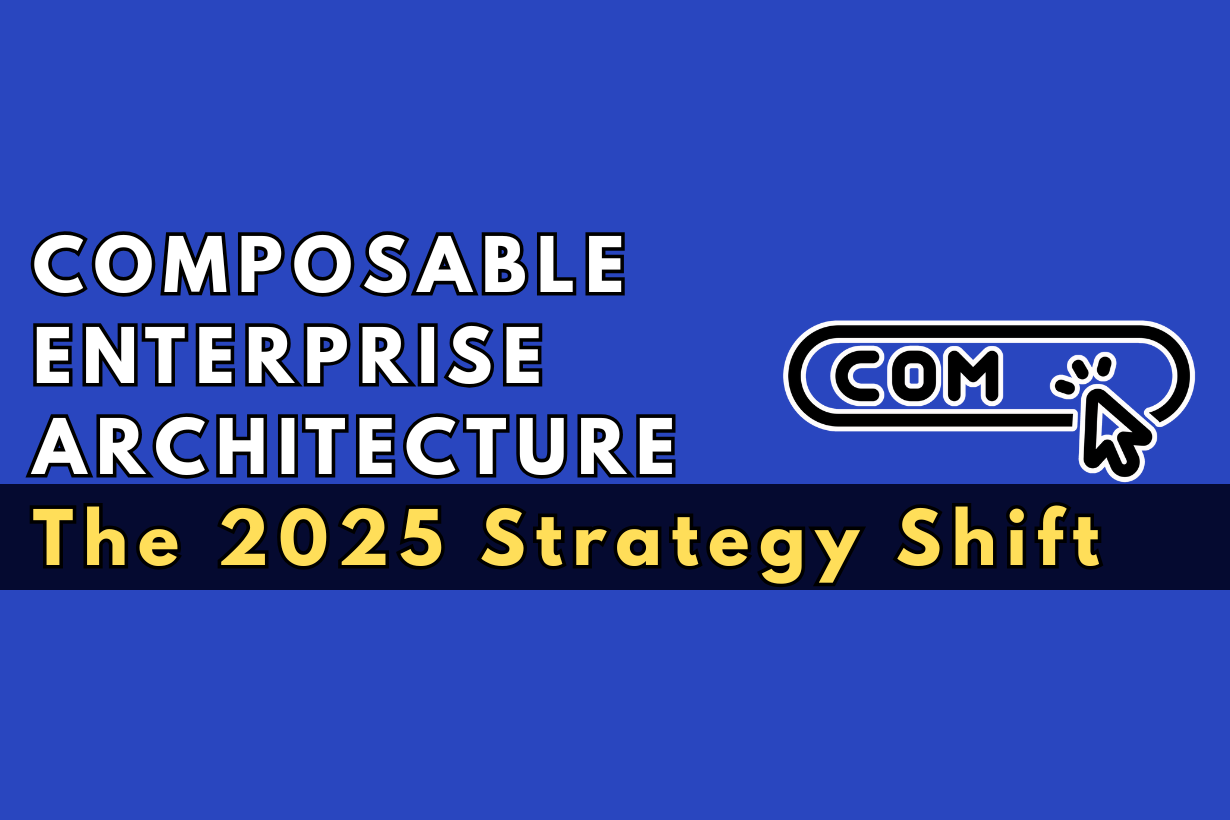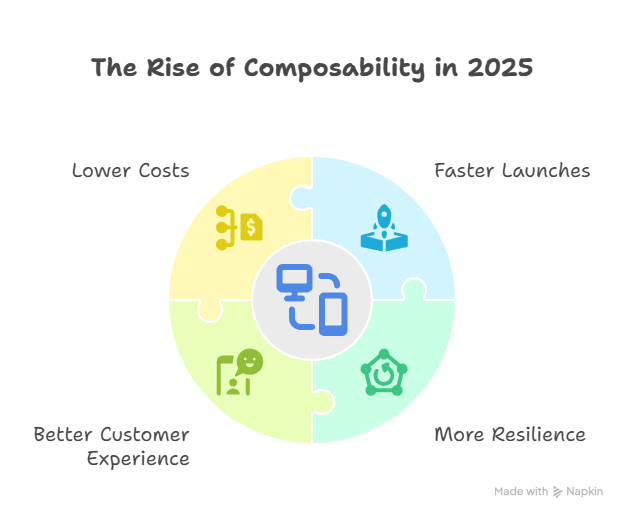
Composable Enterprise Architecture: The 2025 Strategy Shift
- by Indu Sharma
In today’s fast-moving world of business and tech, flexibility isn’t just a nice-to-have; it’s essential. As we dive into 2025, one of the biggest shifts we’re seeing is the rise of the composable enterprise strategy 2025. For companies in India trying to keep up, embracing composable architecture in India isn’t just a new trend; it’s becoming the smartest way forward.
Let’s break it all down, what this strategy really means, why it’s a big deal in 2025, how Indian businesses are already using it, and how you can start bringing it into your own organization.
What is Composable Enterprise Architecture?
Think of your business like a Lego set. Every Lego piece is a function, like customer service, HR, payments, product delivery, etc. With a composable enterprise, you can take these pieces apart, update them, or rearrange them without having to tear down the whole structure.
That’s the core idea behind composable architecture. It’s about building your systems with reusable, swappable parts that are easy to change and scale. This helps businesses adapt faster, reduce downtime, and innovate without being slowed down by old, clunky systems.
Instead of one massive system that’s hard to change, you’ve got smaller parts that work together, but can be improved individually. That makes a big difference when customer needs or market conditions change overnight.
Why 2025 is All About Composability

2025 is more than just a new calendar year; it marks a turning point. The demand for digital speed, personalization, and smart operations has never been higher. Companies are under more pressure than ever to deliver fast, evolve constantly, and do more with less.
Here’s why the composable enterprise strategy 2025 is stealing the spotlight:
–Faster Launches: You can roll out new features or updates quickly.
–More Resilience: If one system breaks, the others keep working.
–Better Customer Experience: You can plug in new tools that personalize services.
–Lower Costs: Reusing and upgrading existing parts saves time and money.
The businesses that move towards this approach are the ones staying relevant, competitive, and innovative, no matter what comes their way.
Composable Architecture in India: What’s Happening on the Ground
Indian companies are no strangers to change. From mobile-first adoption to cloud-first solutions, businesses here have always adapted quickly, and 2025 is no different. The use of composable architecture in India is picking up pace fast.
Startups, especially in fintech, are leading the charge. They’re building flexible systems with APIs and microservices that let them launch products faster and scale easily. But even larger companies, like banks, retailers, and healthcare providers, are starting to modernize by breaking up big, inflexible systems.
What’s driving this trend?
Indian consumers want better, faster digital experiences.
Small businesses need affordable, scalable solutions.
Government projects are pushing for more digital innovation.
Cloud platforms like AWS, Google Cloud, and Azure are more accessible than ever.
The Four Building Blocks of a Composable Business
To go composable, you need more than just tech; you need a mindset shift. Here are the four key areas to focus on:
-Modular Thinking: Treat every part of your business like an independent unit that can be reused or upgraded.
-Cloud-First Infrastructure: Cloud makes it easier to build, connect, and grow.
-APIs & Microservices: These let your systems “talk” to each other seamlessly.
-People Power: Encourage a company culture where teams are open to change, collaboration, and experimentation.
Going composable isn’t just the IT team’s job. Leaders, product managers, marketers, and customer service teams all need to be part of the journey.
Real-Life Examples: Composability in Action
Here’s how different industries are putting the strategy to work:
-
Retail
A retail brand separated its inventory, CRM, and payment systems so it could update or tweak one part without touching the others. Promotions, pricing, and delivery can now be changed on the fly.
-
Banking
A digital bank set up its services, like user login, fund transfers, and loan processing, as microservices. Want to upgrade the loan tool? No problem, it won’t affect the rest of the system.
-
Healthcare
Hospitals are using composable tools to connect patient records, wearable device data, and online consultations. That way, doctors get real-time info and patients get better care.
-
Manufacturing
An auto manufacturer connected procurement, inventory, and production systems using modular components. When suppliers were delayed, it automatically adjusted orders.
These examples show how composability reduces complexity and makes organizations more agile and resilient.
How to Get Started with Composable Strategy in 2025
Thinking of making the switch? Here’s a simple roadmap to begin adopting the composable enterprise strategy 2025:
-Evaluate What You Have: Identify systems or workflows that can be modular.
-Start Small: Focus on one department or function to begin with.
-Choose the Right Tech: Invest in tools that support APIs, microservices, and low-code solutions.
-Train Your People: Upskill your teams so they understand and embrace the new approach.
-Break Down Silos: Encourage collaboration across IT, operations, and business units.
-Measure Progress: Track metrics like speed to market, system uptime, and user satisfaction.
Remember, composability is a mindset as much as a method. Start small, learn fast, and grow from there.
Why This Matters for Indian Businesses
India’s business environment is built for scale and speed. Here’s why composable architecture in India is a perfect fit:
-Massive Scale: Modular systems handle high-volume traffic better.
-Young, Digital-Savvy Users: They expect personalized, responsive services.
-Value-Driven Market: Reusability and cost efficiency matter more than ever.
-Supportive Policies: Government programs are encouraging digital-first models.
From unicorn startups to legacy giants, every company in India can benefit from being more flexible and future-ready.
What’s Next for Composability in India?
Looking ahead, composable will become the new normal. Businesses won’t ask Should we go composable?, they’ll ask How fast can we get there?
Here’s what we expect to see soon:
-More plug-and-play enterprise tools
-Smarter, AI-powered business components
-Growing demand for talent in modular tech
-Industry-wide ecosystems of reusable digital parts
-Those who embrace this early will lead in innovation, growth, and customer satisfaction.
Final Thoughts
In 2025, businesses need to be fast, flexible, and future-proof. The composable enterprise strategy 2025 gives Indian companies the tools to get there.
You don’t have to start from scratch. You just need to start thinking in parts, not wholes. Take a step back, see what you can modularize, and begin building a business that’s ready for anything.
The future belongs to businesses that can bend without breaking. With composability, yours can too.
Frequently Asked Questions
Q1. What is a composable enterprise strategy in 2025?
It’s a flexible approach to building business systems using modular parts like APIs, microservices, and cloud platforms, making it easier to scale, adapt, and innovate quickly.
Q2. How is composable architecture being adopted in India?
Indian startups and enterprises across finance, healthcare, and retail are moving to composable systems for faster service delivery and improved scalability.
Q3. What are the main benefits of adopting a composable enterprise model?
It helps businesses launch faster, improve resilience, personalize customer experiences, and lower costs through reusable components.
In today’s fast-moving world of business and tech, flexibility isn’t just a nice-to-have; it’s essential. As we dive into 2025,…
